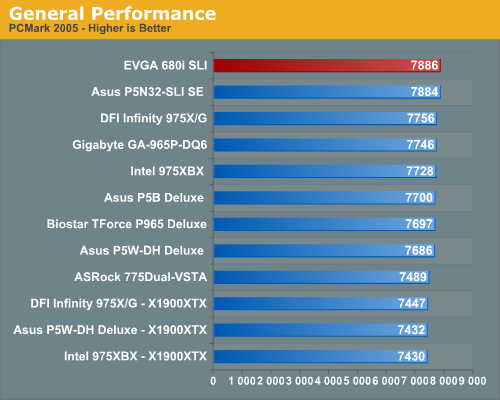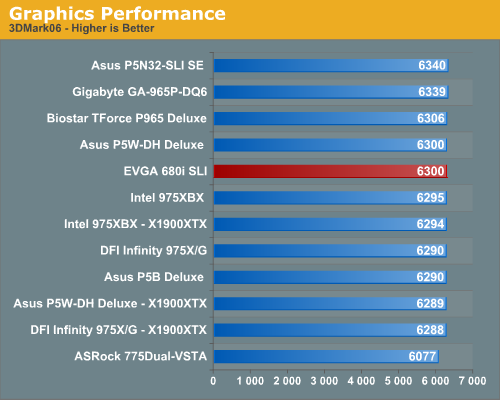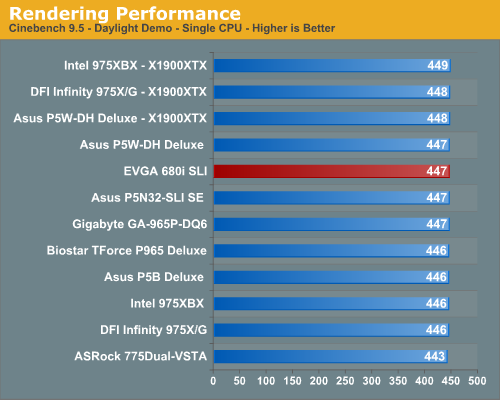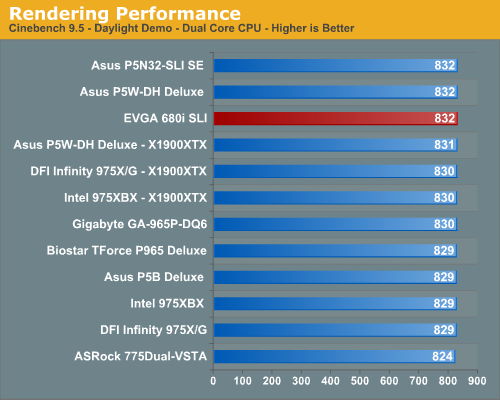NVIDIA 680i: The Best Core 2 Chipset?
by Gary Key & Wesley Fink on November 8, 2006 4:45 AM EST- Posted in
- CPUs
General System Performance
The PCMark05 benchmark developed and provided by Futuremark was designed for determining overall system performance for the typical home computing user. This tool provides both system and component level benchmarking results utilizing subsets of real world applications or programs. The test is useful for providing comparative results across a broad array of graphics subsystems, CPU, hard disk, and memory configurations along with multithreading results. In this sense we consider the PCMark benchmark to be both synthetic and real world in nature while providing consistency in our benchmark results.

The 680i leads the PCMark 2005 results, but scores are close at the top. While the 975X/P965 and 680i are close in performance, the 680i provides a slight edge in General Performance - about 1% which can be considered negligible.
General Graphics Performance
The 3DMark series of benchmarks developed and provided by Futuremark are among the most widely used tools for benchmark reporting and comparisons. Although the benchmarks are very useful for providing apple to apple comparisons across a broad array of GPU and CPU configurations they are not a substitute for actual application and gaming benchmarks. In this sense we consider the 3DMark benchmarks to be purely synthetic in nature but still valuable for providing consistent measurements of performance.

Our nForce 680i SLI results are essentially the same as the performance of the 590 and Intel 975x/965 families. Since the most recent 3DMark06 is very tied to the GPU, this does not come as much of a surprise.
Rendering Performance
The Cinebench 9.5 benchmark heavily stresses the CPU subsystem while performing graphics modeling and rendering. We utilize the standard benchmark demos along with the default settings. Cinebench 9.5 features two different benchmarks with one test utilizing a single core and the second test showcasing the power of multiple cores in rendering the benchmark image.


The nForce 600i desktop platform shows competitive performance in these benchmarks. The range of results are not performance differences you will see looking at the daily performance of 975X and 680i systems.
The PCMark05 benchmark developed and provided by Futuremark was designed for determining overall system performance for the typical home computing user. This tool provides both system and component level benchmarking results utilizing subsets of real world applications or programs. The test is useful for providing comparative results across a broad array of graphics subsystems, CPU, hard disk, and memory configurations along with multithreading results. In this sense we consider the PCMark benchmark to be both synthetic and real world in nature while providing consistency in our benchmark results.

The 680i leads the PCMark 2005 results, but scores are close at the top. While the 975X/P965 and 680i are close in performance, the 680i provides a slight edge in General Performance - about 1% which can be considered negligible.
General Graphics Performance
The 3DMark series of benchmarks developed and provided by Futuremark are among the most widely used tools for benchmark reporting and comparisons. Although the benchmarks are very useful for providing apple to apple comparisons across a broad array of GPU and CPU configurations they are not a substitute for actual application and gaming benchmarks. In this sense we consider the 3DMark benchmarks to be purely synthetic in nature but still valuable for providing consistent measurements of performance.

Our nForce 680i SLI results are essentially the same as the performance of the 590 and Intel 975x/965 families. Since the most recent 3DMark06 is very tied to the GPU, this does not come as much of a surprise.
Rendering Performance
The Cinebench 9.5 benchmark heavily stresses the CPU subsystem while performing graphics modeling and rendering. We utilize the standard benchmark demos along with the default settings. Cinebench 9.5 features two different benchmarks with one test utilizing a single core and the second test showcasing the power of multiple cores in rendering the benchmark image.


The nForce 600i desktop platform shows competitive performance in these benchmarks. The range of results are not performance differences you will see looking at the daily performance of 975X and 680i systems.










60 Comments
View All Comments
Wesley Fink - Thursday, November 9, 2006 - link
The other time you might need a fan on the northbrdige is when using water cooling or phase-change cooling. There is no air-flow spillover from water-cooling the CPU like there is with the usual fan heatsink on the CPU, so the auxillary fan might be needed in that situation.Wesley Fink - Thursday, November 9, 2006 - link
The 680i Does NOT require active notrthbridge cooling and is shipped as a passive heatpipe design. At 80nm it is much cooler than the 130nm nVdia chipsets. The fan you see in the pictures is an included accessory for massive overclocking, much like Asus includes auxillary fans in their top boards.In our testing we really did not find the stock fanless board much of a limitation in overclocking as the northbridge did not get particularly hot at any time. We installed the fan when we were trying to set the OC record and left it on for our 3 days at 2100 FSB. Since it is a clip and 3 screws to install we left it on.
IntelUser2000 - Monday, November 13, 2006 - link
That's funny. A cooler running one consuming more power. Must be the die size is much larger :D.
yacoub - Thursday, November 9, 2006 - link
ah okay thanks for that clarification! =)yacoub - Thursday, November 9, 2006 - link
NTune would be a lot more interesting if it wasn't so slow to respond to page changes, cumbersome, and a gigantic UI realestate hog.The same functionality in a slimmer, more configurable, and efficient UI design would be highly desireable.
yacoub - Thursday, November 9, 2006 - link
and actually, that goes for the entire NVidia display/GPU settings configuration panel.Khato - Wednesday, November 8, 2006 - link
Each CPU is going to have a max FSB clock that it'll run stably at for the same reason that it has a max core logic frequency. The main difference here is that you have two possible barriers: signal degredation due to the analog buffers not being designed for such high speed and then whatever buffer logic there is in the CPU to clock cross from FSB to core not liking the higher frequency. I'm kinda leaning towards the buffer logic being the limiting factor, since I'd expect the manufacturing variance in the analog buffers to be minimal. That and the described 75MHz variance in top FSB frequency between various processors sounds reasonable for non-optimized logic.Staples - Wednesday, November 8, 2006 - link
I have no need for SLI. Makes the board more expensive and an SLI setup is just not worth it to me. I was about to buy a P965 chipset but now I am interested in a the 650i Ultra. Will we see a review of this chipset in the future? Most of it seems to be exactly the same as the 680i however it does lack some features and I am afraid that those missing features may affect performance. As it stands now, do you expect the performance of the 650i Ultra to perform identical to the 680i SLI?Gary Key - Wednesday, November 8, 2006 - link
We do not, we do expect the 650i SLI to perform closely to it. We will have 650i boards in early December for review. :)
Pirks - Wednesday, November 8, 2006 - link
is this functionality where you can overclock your CPU and FSB and memory on the fly without rebooting Windows available only on nForce mobos? I'm a stability freak and I want to be able to raise and lower my clocks and voltage on the fly, similar to the way Macs do this - they spin their fans under load and become totally quiet when idle - I wanna do the same so that my rig is dead quiet when idle/doing word/inet/email/etc and becomes noisy and fast OCed beast when firing up Crysis or something. and I want this Mac-style WITHOUT rebooting Windowsso do I have to buy nVidia mobo for that?
600i series only or earlier nForce 4 or 5 series will do as well?
I still can't dig what's up with these "dynamic BIOS updates that _require_ reboot to work" - so can you OC without rebooting or not? if yes - what are these BIOS options that nTune changes that DOES require reboot?
could you happy nTune owners enlighten me on that stuff? thanks ;)